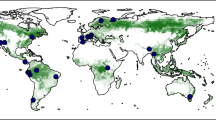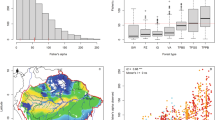Abstract
Biologists have long recognized the striking geographical variability of species richness1. A primary goal of contemporary ecology is to identify the factors responsible for this variability2. We have examined the spatial distributions of trees in North America to determine which characteristics of the environment are most closely related to the species richness of different regions. Realized annual evapotranspiration, which is correlated with primary production and is therefore a measure of available energy, statistically explains 76% of the variation in species richness. Topography and proximity to the sea are significantly related to the residual variation, whereas seasonal climatic variability and glacial history are not. Tree richness in Great Britain and Ireland can be accurately predicted from these North American patterns. Our data are best explained by the hypothesis that contemporary available energy limits species richness3,4.
This is a preview of subscription content, access via your institution
Access options
Subscribe to this journal
Receive 51 print issues and online access
$199.00 per year
only $3.90 per issue
Buy this article
- Purchase on Springer Link
- Instant access to full article PDF
Prices may be subject to local taxes which are calculated during checkout
Similar content being viewed by others
References
Wallace, A. R. Tropical Nature and Other Essays (Macmillan, New York, 1878).
May, R. M. Ecology 67, 1115–1126 (1986).
Brown, J. H. Am. Zool. 21, 877–888 (1981).
Turner, J. R. G., Gatehouse, C. M. & Corey, C. A. Oikos 48, 195–205 (1987).
Simpson, G. G. Syst. Zool. 13, 361–389 (1964).
Cook, R. E. Syst. Zool. 18, 63–84 (1969).
Schall, J. J. & Pianka, E. R. Science 201, 679–686 (1978).
Pianka, E. R. Am. Nat. 100, 33–46 (1966).
Begon, M., Harper, J. L. & Townsend, C. R. Ecology (Sinauer, Sunderland, Massachusetts, 1986).
Brown, J. H. & Davidson, D. W. Science 196, 880–882 (1977).
Birks, H. J. B. Am. Nat. 115, 600–605 (1980).
Abramsky, Z. & Rosenzweig, M. L. Nature 309, 150–151 (1984).
Little, E. J. Jr Atlas of United States Trees Vols 1–5 (US Govt Printing Office, Washington, DC, 1971).
Elias, T. S. The Complete Trees of North America (Reinhold, New York, 1980).
Hosie, R. C. Native Trees of Canada 8th edn (Supplies and Services Canada, Ottawa, 1980).
International Map of the World 1:1,000,000 1969. Canadian sheets (Dept of Energy Mines and Resources, Ottawa, 1973).
World (North America) Army Map Service, Corps of Engineers 1:1,000,000, 1941–1953 US sheets (US Geol. Surv., Washington, DC, 1967).
USSR Committee for the International Hydrological Decade Atlas of World Water Balance (UNESCO Press, Paris, 1977).
The National Atlas of Canada (Macmillan, Ottawa, 1981).
Climatic Atlas of North and Central America (World Meteorol. Org., Geneva, 1979).
Climatic Atlas of the United States (US Dept Commerce National Climatic Center, Ashville, North Carolina, 1968).
Prest, V. K. Retreat of Wisconsin and Recent Ice in North America, Map 1257A (Geol. Surv. Canada, Ottawa, 1969).
SAS User's Guide: Statistics version 5 (SAS Institute, Cary, North Carolina, 1985).
Rosenzweig, M. L. Am. Nat. 102, 67–74 (1968).
Leith, H. in Primary Productivity of the Biosphere (eds Lieth, H. & Whittaker, R. H.) 237–263 (Springer, New York, 1975).
Brown, J. H. & Gibson, A. C. Biogeography (Mosby, St Louis, 1983).
Perring, F. H. & Walters, S. M. (eds) Atlas of the British Flora (Nelson, London, 1962).
Clapham, A. R., Tutin, T. G. & Warburg, E. F. Flora of the British Isles (Cambridge University Press, 1962).
Silvertown, J. J. Biogeogr. 12, 519–525 (1981).
Author information
Authors and Affiliations
Rights and permissions
About this article
Cite this article
Currie, D., Paquin, V. Large-scale biogeographical patterns of species richness of trees. Nature 329, 326–327 (1987). https://doi.org/10.1038/329326a0
Received:
Accepted:
Issue Date:
DOI: https://doi.org/10.1038/329326a0
This article is cited by
-
Global multifaceted biodiversity patterns, centers, and conservation needs in angiosperms
Science China Life Sciences (2024)
-
An updated floristic map of the world
Nature Communications (2023)
-
Using consensus mapping methods as an efficient way of depicting avian distributions in the Caatinga Dry Forest, a poorly known Neotropical biome
Ornithology Research (2022)
-
Determining ecosystem functioning in Brazilian biomes through foliar carbon and nitrogen concentrations and stable isotope ratios
Biogeochemistry (2021)
-
Do constrained immigration rates and high β diversity explain contrasting productivity–diversity patterns measured at different scales?
Oecologia (2020)
Comments
By submitting a comment you agree to abide by our Terms and Community Guidelines. If you find something abusive or that does not comply with our terms or guidelines please flag it as inappropriate.



